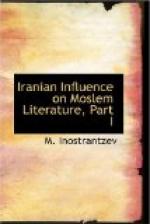[Footnote 1: That is after the style of the Sasanian bass-reliefs which were preserved in his time on the rocks in the vicinity of Shapur and the most famous type of which are the bass-reliefs representing the triumphs of the Sasanian Shapur I, over the emperor Valentine].
These facts generally important for the history of the preservation of the epic, historic and artistic traditions of Iran, are particularly important for the investigation of the sources of the Arabic translations of the Sasanian chronicles and of the epopee of Firdausi. As we know, the translators of these chronicles were Persian “fire-worshippers” or Musalmans who had adopted Islam only externally and had remained true to the ancient Persian religion. Among them the foremost is called Mobed belonging to the city of Sabur in the province of Fars. He is important as a worker in the Iranian historical tradition and about him we shall have occasion to speak later on. This Mobed probably made Arabic translations of Sasanian chronicles from materials in the archives in the castle of Shiz. Further, the information adduced by us above regarding the castle refers to times a little previous to the age of Firdausi and undoubtedly among the materials in these archives were the sources of the Shah Nameh which were available to Firdausi through intermediate versions. Finally, we see that these Sasanian histories were illustrated, a fact which is confirmed by the statement of other Arab writers as we shall see later on. Generally the district of Arrajan enjoyed its ancient glory with reference to its cultural connections. Yakut[1] has preserved for us the information that at Raishahar in the district of Arrajan there lived in the Sasanian times men, versed in a peculiar species of syllabary who wrote medical, astronomical and logical works.
[Footnote 1: “Muajjam ul Buldan”, ed. Wustenfeld, II, p. 887. This passage has been translated by Barbier de Maynard in his “Geographical, Historical and Literary Dictionary of Persia”, in French, pp. 270-271. See also Fihrist II, p, 105.]
What we have studied above establishes the existence of Persian literary tradition in its national form for several centuries after the Arab invasion. Now we have to survey wherein lie the characteristic features of this tradition and what were its main contents. And we pass on to their consideration.
CHAPTER II
The Parsi Clergy and the Musalman Iranophile party of the Shuubiya 26
The part played by them in the conservation of the Persian literary tradition 30
The different varieties of this tradition; scientific, epico-historic, legendary and ethico-didactic 32
PARSI CLERGY PRESERVE TRADITION




